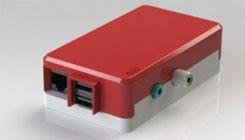
Ten years ago, you'd be hard pressed to find a full-featured, fanless, small-footprint Linux machine. Today there are quite a few models around, from the purely hackable
Raspberry Pi to the industrial strength FitPC2. They're cheap, too: The Pi costs a measly $35. Here's a list of interesting off-the-shelf, nano-Linux devices just waiting to be hacked and rolled into new products or services.
Raspberry Pi
This is the current darling of the Linux hacking crowd. It has a 700 Mhz processeor and 256 MB of RAM and uses an SD card for booting and storage. You can hook up a TV to act as a monitor using either a composite video or HDMI output. There are also standard Ethernet, USB and audio ports for the networking, keyboard and sound functions. A row of general I/O ports hook the Pi up to various sensors and external devices. They're programmed using Python. The Pi can be loaded with a variety of Linux variants including Debian, Arch Linux and ARM distributions. Others are in the works.
Rascal Micro
This little powerhouse combines the engine of a Web server with the ability to accept Arduino shields. Combine sensors with Python to easily put data up on the Web. Microprocessor specifics and Linux versions were a bit sketchy. Nevertheless, it looks to be a useful board.
CubieBoard
Featuring a 1 GHz ARM processor and up to 1 GB of RAM, the CubieBoard is a powerful little machine. It has HDMI output for the video and 10/100 Ethernet. It runs Android, Ubuntu and several other Linux distros. Among other things, you can use the CubieBoard for making an Android TV, an Ubuntu desktop or a network-attached storage device.
FitPC2
This powerful, nearly bulletproof box features an Intel Atom processor running at 1.6 GHz. It has 1 GB of RAM and a 2.5 SATA hard disk. Video works through HDMI, and there are six USB ports. Because the machine is billed as very strong on video playback, naturally there's GigaBit Ethernet. Linux Mint is the default distribution, although it can run other versions of Linux and even accommodate Windows 7.
Hackberry
This board features a 1.2 GHz ARM processor that can run either Android or Linux. It has hardware acceleration for graphics with HDMI and composite video ports as output. It boots and runs from an SD card and has built-in wired and WiFi network connectivity
Related Links
 Ten years ago, you'd be hard pressed to find a full-featured, fanless, small-footprint Linux machine. Today there are quite a few models around, from the purely hackable Raspberry Pi to the industrial strength FitPC2. They're cheap, too: The Pi costs a measly $35. Here's a list of interesting off-the-shelf, nano-Linux devices just waiting to be hacked and rolled into new products or services.
Ten years ago, you'd be hard pressed to find a full-featured, fanless, small-footprint Linux machine. Today there are quite a few models around, from the purely hackable Raspberry Pi to the industrial strength FitPC2. They're cheap, too: The Pi costs a measly $35. Here's a list of interesting off-the-shelf, nano-Linux devices just waiting to be hacked and rolled into new products or services.
 Ten years ago, you'd be hard pressed to find a full-featured, fanless, small-footprint Linux machine. Today there are quite a few models around, from the purely hackable Raspberry Pi to the industrial strength FitPC2. They're cheap, too: The Pi costs a measly $35. Here's a list of interesting off-the-shelf, nano-Linux devices just waiting to be hacked and rolled into new products or services.
Ten years ago, you'd be hard pressed to find a full-featured, fanless, small-footprint Linux machine. Today there are quite a few models around, from the purely hackable Raspberry Pi to the industrial strength FitPC2. They're cheap, too: The Pi costs a measly $35. Here's a list of interesting off-the-shelf, nano-Linux devices just waiting to be hacked and rolled into new products or services.


